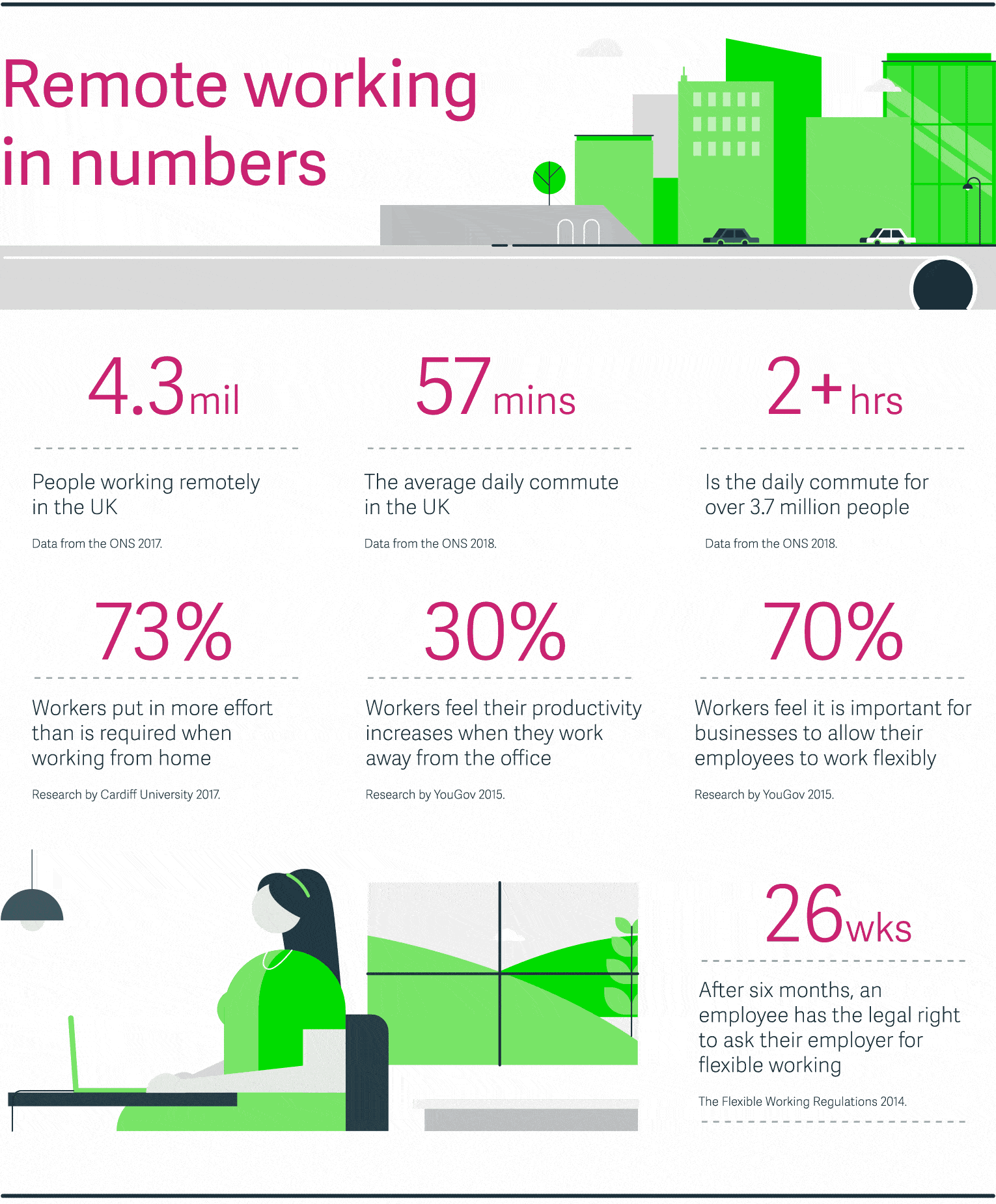Strategy, Legal & Operations
A guide to remote working and virtual teams


In 2017, more than 4.3 million people worked remotely in the UK. The latest data from the Office for National Statistics (ONS) shows that three quarters of these people were experienced professionals who work in the highest skilled areas of the economy.
Research carried out by the TUC, has found that in the last decade the number of workers who say they usually work from home has increased by a fifth. This growing trend is partially in response to companies trying to recruit top talent by offering a better work-life balance.
On a global scale, the World Economic Forum’s most recent forecast of employment trends called flexible working, such as virtual teams, “one of the biggest drivers of transformation”.
Tech companies such as Zapier, Basecamp, Github and Microsoft are pioneering different approaches to virtual teams. Employers such as the Civil Service, Vodafone, Transport for London and Unilever are regularly praised by workers for their flexible work culture. While charities such as Unicef have tapped into the potential offered by spreading teams across time zones.
Remote working is not just for multinationals. Small businesses can also embrace the virtual team, with productivity and access to the best talent being the biggest benefits. Research shows that employees working remotely are highly productive, motivated and committed to their employers.
Much like the rise of home delivery from supermarkets has disrupted how we purchase food, remote working has the ability to change the way we approach the traditional office structure. The massive benefit from this is a huge reduction in commuting and the impact this could have on pollution.
“The benefits are immense: a better lifestyle, with positive benefits for recruitment and retention; a reduced carbon footprint; enhanced accommodation of diversity; better mental and physical health; improved productivity; more effective use of property.” – Bruce Mann, former Cabinet Office finance director, Civil Service
Building a virtual business
Want to turn your business into one that's flexible, efficient and doesn't confine you to the office? Get our free guide and discover how you can save time and money by building your own virtual business.

The rise of remote working and virtual teams
The evolution of technology has liberated people from the traditional workplace and the standard nine-to-five working day.
Only a few years ago, remote working would be limited to roles such as copywriting or journalism, which required limited customer-facing work and were not reliant on the traditional office environment. The majority of jobs required employees to complete physical paperwork and to attend meetings with clients or colleagues in person.
The development of the cloud, laptops and smartphones has meant that anywhere an employee can connect to the internet can be their main working desk. Business meetings can be conducted thousands of miles apart through the use of video conferencing software, with documents being shared digitally in real time.
The ONS’s Annual Population Survey in 2017 found that more than 1.8 million people solely worked at home in the UK. A further 2.8 million worked in different places but still kept their home as a base.
These employees tend to be older and highly skilled. In 2014, ONS researchers found that of the more than four million remote workers in the UK, 14.8% were working as managers or senior officials, 35.2% were professionals or associate professionals and a further 23.5% were working within skilled trades.

What are the benefits to employees of working remotely?

More free time. Without a commute to a workplace, an employee has more time. The average worker spends 57.1 minutes of their working day commuting, according to the most recent ONS data, with more than 3.7 million people spending more than two hours commuting daily.
Better work-life balance. As a result of having more time and being able to set their own working day, employees can spend more time with their families, taking exercise or on a side project leading to improvements in their health, emotional well-being and stress levels.
Flexibility. The ability to manage their own time, means employees can work around other commitments. Having to care for children or elderly parents results in many people not being able to take full-time work even when they want to. The ability to choose the hours when they work means an employee can manage a full-time job and their other responsibilities.

Increased productivity. Research by Cardiff University has found that 73% of workers revealed they put in more effort than is required when working from home. This improves the employment prospects of employees and provides huge value to employers.
Empowering. Staff are trusted by their employer to set their own hours and to work while away from a central office. By being trusted to manage their own time and productivity, an employee can take ownership of their workload which cultivates a deeper sense of responsibility. The result is empowering for an employee when they feel in control of their working day.
Increased job satisfaction. Research shows that remote workers have higher levels of job satisfaction, job-related well-being and overall are more committed to their company, regardless of its size.
Building a virtual business
Want to turn your business into one that's flexible, efficient and doesn't confine you to the office? Get our free guide and discover how you can save time and money by building your own virtual business.

How does remote working impact on productivity?
In 2014, Stanford University academics conducted research with Chinese travel company Ctrip. The travel firm employed more than 16,000 workers and wanted to see if remote working could help them cut costs.
When the company rolled out the option to work from home to the whole company, the performance rate of remote workers almost doubled to 22%. The remote workers took fewer breaks or sick days and also made more calls per minute. Ctrip also estimated that it saved on average $1,900 per employee over the course of the nine-month study by not having to supply office space and furniture.
“Ctrip was thinking that it could save money on space and furniture if people worked from home and that the savings would outweigh the productivity hit it would take when employees left the discipline of the office environment. Instead, we found that people working from home completed 13.5% more calls than the staff in the office did — meaning that Ctrip got almost an extra workday a week out of them. They also quit at half the rate of people in the office — way beyond what we anticipated. And predictably, at-home workers reported much higher job satisfaction.” – Nicholas Bloom,13 Professor of Economics at Stanford University
Research conducted by YouGov in 2015 found that 30% of UK office workers felt their productivity increased when they worked away from the office. Out of 2,000 workers surveyed, 70% felt it was important for businesses to allow their employees to work flexibly.
The British Civil Service has reported increased productivity among its staff as well as an overall improvement in their emotional well-being, following the introduction of remote working initiatives. Recent examples include the Department for Transport recruiting for ‘location neutral’ roles and the Home Office developing new office space in Manchester, with hot desking options so staff can either choose to come into an office or work remotely.
In 2017, the chief executive of the Civil Service John Manzoni said the Way We Work Programme helped to reduce the size of crown estate by 300,000 square metres (or seven Wembley Stadiums). The traditional office space in expensive city centre locations wasn’t required as more staff chose to work remotely.
Why should a business build a virtual team?

Availability of talent. Access to the best candidates worldwide is the predominant reason why any business should consider recruiting for a remote role. Decisions can be based on a candidate’s skills and enthusiasm for a role, rather than the fact that they live a commutable distance from the office.
A significant cost saving. The cost of providing a laptop to a virtual team member is significantly less than providing a desk in a large office with heating, maintenance and electricity bills. A company could also massively reduce its overheads by operating from a smaller office ‘hub’ and by employing a virtual team.
An ‘always-on’ service. The ability to provide 24-hour coverage is an affordable possibility if a company has a team based in different time zones. Unicef’s Global Innovation Centre’s team of 17 people in 11 different locations allows them to pass a project between colleagues, ensuring that when faced with humanitarian disasters they are able to deliver within a 24-hour timescale.
Easy to scale. For a small business with aspirations to expand, remote workers can bridge the gap to scale without having to take on huge overhead increases. A company can simply add more members to their existing virtual teams or create new groups for specific projects. For example, bringing in a remote sales team to help drive business in new markets.

Increased productivity. As mentioned above, remote workers are more productive than office-based employees and are less likely to have sick days or to leave a company.
Loyalty. In a small business, high staff turnover can cause problems. A remote team who are proven to be hard working and loyal to their employer are a more secure and stable option.
How a small business can hire a remote team
A remote worker has to be self-motivated, disciplined and able to manage their time. They must also be happy working independently, without the social support that comes from a traditional office and these are vital qualities to look out for when hiring.
When considering the move to building a remote team, you should first look at existing employees who are suited to the role and who display the right aptitude. These employees could help to lead and build a remote team.
Even if a company’s existing staff are not suited to remote working, they are still the best resource a small business has for finding good candidates. Good people know good people and having a reward scheme for referring potential remote workers can bring smaller brands to the attention of top talent.
Other channels for finding new employees include specialist remote working job sites, such as WeWorkRemotely, FlexJobs and Remote.com. For short-term positions People Per Hour and Upwork have the broadest range of people and a freelance position could become a permanent role.
Create a ‘hiring’ page on your website with job descriptions and advertise this through social media channels such as Linkedin or Twitter.
Before a new remote worker is put on the payroll, it’s essential to run a test project with a candidate to ensure they can both manage their time and communicate effectively. Also run an interview with the team that will be in direct communication with the new employee to ensure a good fit both with the company culture and the people that they will be working directly.
“When it comes to an all-new position at the company, we like to try to do it first with the people we have so we really understand the work. If you don’t understand the work, it’s really hard to evaluate someone’s abilities. Before we hired our first customer service person, I did just about all the customer service for two years… That really helped us know who would be good when we started talking to people about the job.” – Jason Fried, co-founder Basecamp

How to ensure you build team culture
Once a company has recruited the staff for their remote team, it’s important to look at how this group will work together in the most productive way. Establishing several ‘touching base’ and crossover points throughout the work day and working week ensures staff who might be in several time zones are able to stay connected.
When a person joins a new remote team, it’s important that they are made to feel welcome and supported. Use a ‘buddy’ system with an existing team member taking the time to help a new employee integrate. The buddy can be in contact every day to answer questions and, most importantly, to ensure that the new team member doesn’t become demoralised or isolated.
“The struggle is real; those first few days working remote seem so awkward, and you’ll spend at least 10% of your time wondering if you’re doing the right thing.” – Greg Ciotti, content marketing lead, Shopify
Regular feedback from managers in a one-to-one session is essential, especially in the first few months, so the new employee can develop into their role and be reassured both of their performance and that they are doing enough.
The key to ensuring a harmonious working group is to remind everyone to think carefully about their choice of language before sending emails or instant messages. Also explain any nuances of language to a new employee, such as gifs or memes used in group chat and any ‘in jokes’, to avoid unnecessary offence or stress.
Most importantly, bringing the entire team together on a periodic basis is essential to build the company culture and meeting in person cannot be bettered for creating good team harmony and spirit.
Many companies organise retreats for their staff in locations where they can all be together as they work, while also enjoying out-of-hours time getting to know each other. Whether this is in a lively city environment or out in the wilderness, employing ‘survival’ skills depends on the company values and culture that you want to build.
“For one week it makes sense to take some time off and work on the team which is just as important as the product itself.” – Wade Foster, CEO, Zapier
Tools and resources that a small business can use for its remote team
For a remote team, communication is the key to ensuring success. A good internet connection, webcam and headset are all essential tools that a company must ensure each employee has access to.
Communication tools
Slack is now used by many organisations as a replacement to internal email and to keep the team up to speed on the latest developments. Conversations between teams are archived and searchable, ensuring that over time a group can build up a knowledge base.
Google Hangouts and Skype are vital for daily one-to-one video calls but can struggle with conference calls. GotoMeeting offers a more reliable video conferencing service for multiple call meetings.
Project management tools
Trello, which has a format similar in style to writing Post-it notes on a wall, helps teams collaborate by clearly showing what work needs to be done.
Basecamp combines instant chat features with project management. The system lets teams create to-do lists, organise a schedule, participate in group chats and save files all in one place, decreasing the chance that something important might slip through the communication net.
Asana is a project management system that places greater focus on the progress of a team. Its emphasis on when tasks are completed means that more detail can be added to each step of the process.
Sharing files
Google Docs has been a revolution in real-time file sharing and is widely adopted across businesses, with the ability for collaboration on a document at the same time for both editing and commenting.
Dropbox has been the most widely used file transfer system, with Google Drive and Microsoft OneDrive gaining ground.

What are the legal implications of offering remote working to employees?
If an employee has worked for the same employer for at least 26 weeks, then they have the legal right to ask for flexible working. In 2014, the government extended this right to remote working to all workers and not just those who have young children.
If an employee wants to work flexibly, they need to write a letter to their employer. This ‘statutory application’ should include the date that they intend to start working remotely and the business case for why they think they should be allowed to do so. The government provides free templates online to help with this.
Once a company has received the application, it’s their legal duty to deal with it in a ‘reasonable manner’ and within a sensible time period. Best practice is three months, unless an extension has been agreed. Within 28 days of approving the request, an employee’s terms and conditions must be changed.
Any employer who wants to reject the request needs to make a business case for doing so.
If hiring a remote worker who is based overseas, then it’s important to ensure the business is compliant with both UK employment law and the employment law of the country in which the employee resides, to avoid any potential problems.
In one recent case, Lodge V Dignity in Choice in Dying, an employee was found to have UK unfair dismissal and discrimination rights, despite not having worked in Britain for several years.
Remote workers in the UK have the same rights as office-based employees to sickness days, maternity and holiday pay.
Having a team member work from home doesn’t discharge a company’s health and safety responsibilities either. The employer will need to carry out a risk assessment and take appropriate steps to reduce any potential harm.
A business is only responsible for work equipment they supply but it should also ensure that remote staff are taking appropriate screen breaks and suitable lunch breaks.
Checks need to be made of a company’s public liability and employer’s liability insurance to ensure a remote worker will be protected when working from home. Also, an employee may need to update their contents or home insurances to reflect the fact that their home is their main place of work.
Finally, following the introduction of GDPR legislation, it is imperative that steps are taken to ensure an employee understands how to protect personal data when working remotely. Laptops, USB sticks and mobile phones should be encrypted and staff need to take steps to ensure that when they are working in public places, such as coffee shops, they don’t accidentally disclose private data.

What are the challenges of managing remote teams?
When working with a remote team, communication and processes need to be maintained to a high standard at all times.
Instant messaging leads to the expectation of instant responses and an employee will quickly reach burnout if they feel they have to be constantly online to answer any question or query.
When dealing with different time zones, companies must be aware when an employee is ‘on’ and ‘off’ the clock. It’s not unreasonable to expect a remote employee to attend an essential meeting or ‘emergency’ out of hours (as an exception) but regularly scheduling events so a worker has to attend a video conference at 2am is not acceptable.
As highlighted above, make crossover points during the day when there are windows of opportunity for handovers and group meetings.
Also note that some countries do give employees a ‘right to switch off’, which means colleagues need to be aware of not sending requests out of agreed working hours. A British firm was recently fined after a French court ruled it was ‘unreasonable’ for a regional manager to be expected to leave his phone on to answer questions when not working.
The truth is that some people work best in the same office as their colleagues and others prefer the freedom of being able to work anywhere they want. Bringing the two together is a challenge but the use of regular video meetings and meet-up retreats can overcome this issue.
Adii Pienaar, the co-founder of WooThemes, was forced to revoke a ‘Fridays work-from-home’ policy for his Cape Town office after suspecting that several staff members were abusing the privilege. This is despite the fact that 60% of his company worked successfully remotely. Using test projects as a trial basis to assess both productivity and company culture fit before hiring should avoid any issues of this nature.
Even experienced employers face challenges at times when dealing with remote workers but with both good practices and processes, managing a remote team should not be any more challenging than dealing with internal teams. Certainly the productivity and benefits to both employee and employer vastly outweigh any challenges.
Remote working, the new model for businesses?
Over the past few decades, the internet has made the world a much smaller place, opening up new opportunities and markets for smaller businesses. As technology affords us the ability to easily make new connections, we are free to focus on who is ‘right’ for our company, rather than who is in the ‘right’ location.
Offering employees a greater work-life balance allows them to be more productive and content in their work. Happy remote staff are incredibly loyal and proactive, improving a company’s culture by their self-discipline and drive. An increasing volume of research shows that putting the right people in their best working environment, is the easiest way a company can make the most of their staff.
Unless you are a business that is dependent on a customer-facing location such as a restaurant or bar, there are few reasons why you shouldn’t consider embracing the opportunities presented by remote working.
Embracing new models of working made available by technology is the future of business and can make for a better society all-round.
“If you want the best talent, limiting yourself to the talent that’s available in a single city (let alone a single country) is shooting yourself in the foot. Half of “Hubbers” work remotely in 18 countries across the globe.” – Coby Chapple, senior product designer, Intercom
Have you considered remote working for your business or is it something you actively encourage? Let us know in the comments below.







Ask the author a question or share your advice